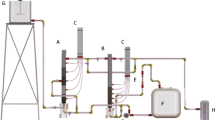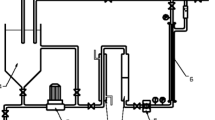Abstract
Introduction
The unhairing step, a part of the beamhouse process, is particularly polluting, generating an alkaline wastewater with high concentrations of organic and inorganic matter. The aim of this study was to evaluate the treatment of this industrial wastewater using a combination of biological and microfiltration processes.
Materials and methods
The performance of the activated sludge system (AS) was evaluated under varying organic loading rate (OLR) from 0.9 to 3.4 kg chemical oxygen demand (COD) m−3 day−1 and decreasing hydraulic retention time (HRT) from 3 to 1.6 days.
Results
For an HRT of 3 days, the increase of OLR significantly affected the removal of organic matter. Therefore, the biological organic matter removal of unhairing wastewater decreased from 92% to 66% for COD and from 87 to 53% for biological oxygen demand (BOD5). GC-MS analyses showed that biological treatment of unhairing wastewater contributed to the removal of long chain fatty acids and their degradation products. Microfiltration of unhairing wastewater was performed using 0.2 μm pore-size membranes in tangential filtration. The highest removal efficiencies were obtained for bacteria (100%) and turbidity (98.4%) which confirmed the importance of the microfiltration step in treatment of unhairing wastewater. The result showed that the flux decay rate was greatest at the start of the microfiltration assay (90 L h−1 m2), becoming 60.7 L h−1 m2 after 32 min.
Conclusion
This change indicated that fouling occurred rapidly once the membrane module was put into operation.








Similar content being viewed by others
References
AFNOR Receuil des normes afnor (1997). Qualité de l’eau, Méthodes d’analyse, Ed. Afnor.
Alonso E, Santos A, Solis GJ, Riesco P (2001) On the feasibility of urban wastewater tertiary treatment by membranes: a comparative assessment. Desalination 141:39–51
Bai R, Leow HF (2002) Microfiltration of activated sludge wastewater-the effect of system operation parameters. Sep Purif Technol 29:189–198
Benítez FJ, Acero JL, Leal AI (2006) Application of microfiltration and ultrafiltration processes to cork processing wastewaters and assessment of the membrane fouling. Sep Purif Technol 50:354–364
Benítez FJ, AceroJL LealAI, González M (2009) The use of ultrafiltration and nanofiltration membranes for the purification of cork processing wastewater. J Hazard Mater 162:1438–1445
Bin Abas MR, Simoneit BRT, Elias V, Cabral JA, Cardoso JN (1995) Composition of higher molecular weight matter in smoke aerosol from biomass combustion in Amazonia. Chemosphere 30:995–1015
Brites AM, De Pinho MN (2000) Ultrafiltration for colour removal of tannery dyeing wastewaters. Desalination 130:47–154
Byss M, Tříska J, Elhottová D (2007) GC-MS-MS analysis of bacterial fatty acids in heavily creosote-contaminated soil samples. Anal Bioanal Chem 387:1573–1577
Cassano A, Molinari R, Romano M, Drioli E (2001) Treatment of aqueous effluents of the leather industry by membrane processes. J Membr Sci 181:111–126
Costa CR, Botta R, Espindola CM EL, Golivi P (2008) Electrochemical treatment of tannery wastewater using DSA® electrodes. J Hazard Mater 153:616–627
Gomèz V, Pasamontes A, Callao MP (2006) Factorial design for optimising chromium determination in tanning wastewater. Microchem J 83:98–104
Karahan Ö, Dogruel S, Dulekgurgen E, Orhon D (2008) COD fractionation of tannery wastewaters—particle size distribution, biodegradability and modelling. Water Res 42:1083–1092
Lefebvre O, Vasudevan N, TorrijosM TK, Moletta R (2005) Halophilic biological treatment of tannery soak liquor in a sequencing batch reactor. Water Res 39:1471–1480
Lefebvre O, Vasudevan N, Torrijos M, Thanasekaran K, Moletta R (2006) Anaerobic digestion of tannery soak liquor with an aerobic post treatment. Water Res 40:1492–1500
Mameri N, Halet F, Drouiche M, Grib H, Lounici H, Pauss A, Piron D, Belhocine D (2000) Treatment of olive mill washing water by ultrafiltration. Can J Chem Eng 78:590–595
Mlaik N, Bouzid J, Gharsallah N, Belbahri L, Woodward S, Mechichi T (2009) Investigation of endogenous biomass efficiency in the treatment of unhairing effluents from the tanning industry. Environ Technol 30:911–919
Ouejhani A, Hellal F, Dachraoui M, Lalleve G, Fauvarque JF (2008) Application of Doehlert matrix to the study of electrochemical oxidation of Cr(III) to Cr(VI) in order to recover chromium from wastewater tanning baths. J Hazard Mater 157:423–431
Parameshwaran K, Fane AG, Cho BD, Kim KJ (2001) Analysis of microfiltration performance with constant flux processing of secondary effluent. Water Res 35:4349–4358
Ratledge C (1978) Degradation of aliphatic hydrocarbons. In: Watkinson RJ (ed) Development in biodegradation of hydrocarbons, 1st edn. Applied Sciences, London, pp 1–46
Ravazzini AM, Van Nieuwenhuijzen AF, Van Der Graaf JHMJ (2005) Direct ultrafiltration of municipal wastewater: comparison between filtration of raw sewage and primary clarifier effluent. Desalination 178:51–62
Sadr Ghayeni SB, Madaeni SS, Fane AG, Schneider RP (1996) Aspects of microfiltration and reverse osmosis in municipal wastewater reuse. Desalination 106:25–29
Scholz W, Lucas M (2003) Techno-economic evaluation of membrane filtration for the recovery and re-use of tanning chemicals. Water Res 37:1859–1867
Sridang Cheng P, Pottier A, Wisniewski Ch, Grasmick A (2008) Performance and microbial surveying in submerged membrane bioreactor for seafood processing wastewater treatment. J Membr Sci 317:43–49
Statistical Package for Social Sciences 9.0 (1999) User manual. SPSS Inc., Chicago
Suthanthararajan R, Ravindranath E, Chitra K, Umamaheswari B, Ramesh T, Rajamani S (2004) Membrane application for recovery and reuse of water from treated tannery wastewater. Desalination 164:151–156
Szpyrkowicz L, Santosh NK, Rao NN, Shanta S (2005) Influence of anode material on electrochemical oxidation for the treatment of tannery wastewater. Water Res 39:1601–1613
Vidal G, Nieto J, Cooman K, Gajardo C, Bornhardt M (2004) Unhairing effluents treated by activated sludge system. J Hazard Mater B122:143–149
Zucconi FA, Pera MF, Bertoldi M (1981) Evaluating toxicity of immature compost. Biocycle 22:54–57
Acknowledgment
The authors wish to thank Pr A. Ayadi from the Engineering School of Sfax for help in the microfiltration assay.
Author information
Authors and Affiliations
Corresponding author
Additional information
Responsible editor: Philippe Garrigues
Rights and permissions
About this article
Cite this article
Mlaik, N., Bouzid, J., Belbahri, L. et al. Combined biological processing and microfiltration in the treatment of unhairing wastewater. Environ Sci Pollut Res 19, 226–234 (2012). https://doi.org/10.1007/s11356-011-0543-z
Received:
Accepted:
Published:
Issue Date:
DOI: https://doi.org/10.1007/s11356-011-0543-z




